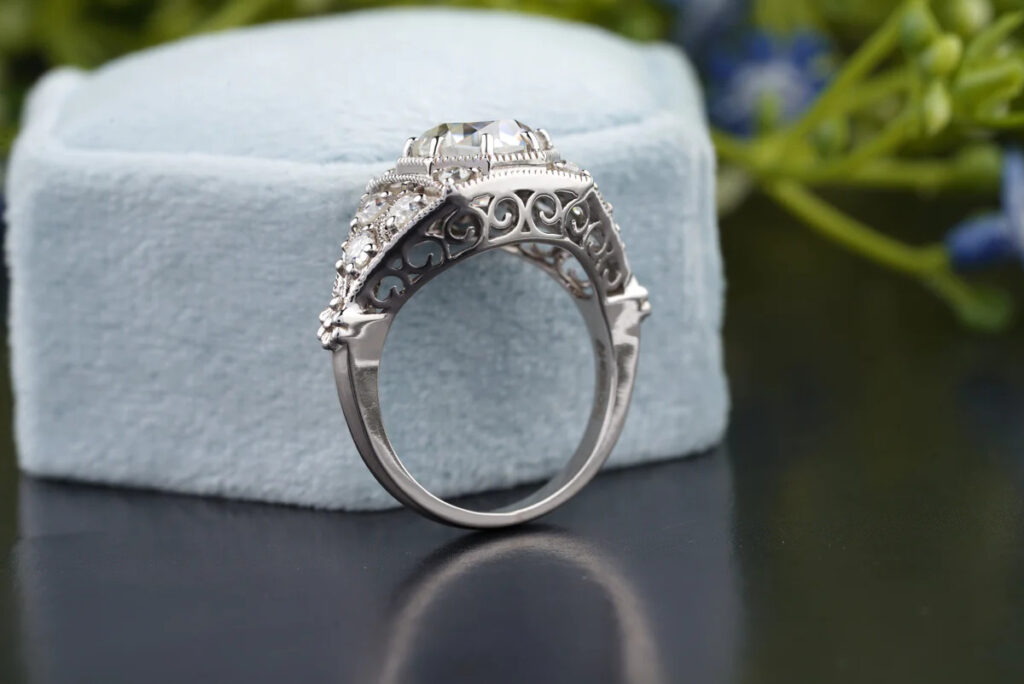Table of Contents
When Did Engagement Rings Start? Let’s find out!
Ah, the engagement ring—a tiny circle that carries a world of meaning. It’s a timeless emblem of love, commitment, and let’s be honest, an excuse for a great Instagram post. But have you ever wondered, when did engagement rings start? Who decided that a sparkling gem on a finger was the ultimate promise of forever?
Buckle up, because we’re about to time-travel through history, unraveling the captivating story of engagement rings—from their humble (and sometimes bizarre) beginnings to their status as a modern love essential. And yes, we’ll be mentioning when did engagement rings start quite a bit—because that’s what you’re here for, right?
Ancient Beginnings: Rings of Power, Love, and Ownership
Our journey begins in ancient Rome, around 200 B.C., where women wore rings made of flint, bone, ivory, or iron. These rings weren’t just pretty accessories; they symbolized a binding contract between a couple. In fact, they were less about romance and more about business—because back then, marriage was more of a transaction than a love story. Romantic, right? (Source)
The Romans also believed in the “vena amoris” (Latin for “vein of love”), a mythical vein running from the fourth finger of the left hand straight to the heart. Though modern science has debunked this, the tradition of wearing engagement rings on this finger remains deeply rooted in many cultures. And for those still wondering when did engagement rings start, this is one of the earliest recorded instances.
Medieval and Renaissance Eras: Diamonds Make Their Debut
Fast forward to 1477, and we meet Archduke Maximilian of Austria. This medieval trendsetter proposed to Mary of Burgundy with a diamond ring arranged in an “M” shape. This moment single-handedly started the trend of diamond engagement rings among European nobility. If only they had Instagram back then! (Source)
In the Renaissance period, engagement rings evolved into gimmel rings, which featured two or three interlocking bands. The couple would each wear a band until their wedding day, when the rings were joined together into one. It’s like a romantic version of a puzzle piece necklace, but way more sophisticated. Again, another fascinating milestone in when did engagement rings start!
The Victorian Era: Romance Meets Extravagance
By the 19th century, engagement rings had become grand symbols of love and devotion. The Victorian era (1837-1901) saw engagement rings incorporating diamonds, colored gemstones, and intricate floral designs. These rings reflected Queen Victoria’s own deep love for Prince Albert, and soon, jewelry from this era was aptly named “romantic jewelry.” Nothing says “I love you” like a ring adorned with rubies and sapphires in the shape of a snake, right? (Source)
The 20th Century: The Diamond Monopoly and “A Diamond is Forever”
Despite their earlier popularity among royals, diamond engagement rings weren’t widespread until the 20th century. If you’re still asking when did engagement rings start in the way we know them today, this is the defining era.
The De Beers Effect
In the late 19th century, diamonds were discovered in South Africa, and the British company De Beers quickly monopolized the diamond market. By the 1930s, diamond sales were plummeting due to the Great Depression.
Then came 1947. Cue the most iconic advertising slogan of all time: “A Diamond is Forever.” This genius marketing campaign by De Beers convinced the world that a diamond engagement ring was essential for true love. Within a few decades, diamond engagement rings had become the norm. Talk about a marketing mic drop! (Source)
The 21st Century: Breaking Traditions and Personalization
Engagement rings today are as diverse as the couples who wear them. While diamonds remain the classic choice, many are embracing alternative gemstones, vintage rings, and even lab-grown diamonds for an ethical, budget-friendly option. Some couples are ditching rings altogether, opting for meaningful tattoos, custom bands, or heirloom pieces.
Additionally, gender norms around engagement rings are evolving. More men are wearing “mangagement rings” (yes, it’s a thing!), and non-traditional couples are redefining what an engagement ring should symbolize. Love has no rulebook, and that’s what makes it so beautiful. No matter what form they take, engagement rings remain an essential part of the conversation about when did engagement rings start.
Fun Facts About Engagement Rings You Probably Didn’t Know
- The world’s most expensive engagement ring belonged to Mariah Carey, worth a cool $10 million. No pressure.
- The smallest engagement ring in history? That would be Beyoncé’s, relatively speaking, because her $5 million ring is tiny compared to her megawatt career.
- Some cultures believe sapphire rings bring fidelity, while others say pearls symbolize tears. Choose wisely!
- In some parts of Scandinavia, both men and women wear engagement rings to symbolize equality. Love that!
- The largest diamond ever used in an engagement ring? The 33.19-carat Krupp Diamond, which belonged to Elizabeth Taylor.
Want a Free Engagement Ring? Here’s Your Chance!
Speaking of engagement rings, wouldn’t it be amazing if you could win one? Well, dreams do come true! At Bridalsphere.com, we’re giving away stunning engagement rings to lucky winners.
And here’s the best part: The more actions you complete, the more giveaway entries you earn! Sign up, follow us on social media, refer friends, and increase your chances of scoring the perfect engagement ring.
Because let’s be real, a free engagement ring means more budget for the honeymoon!
